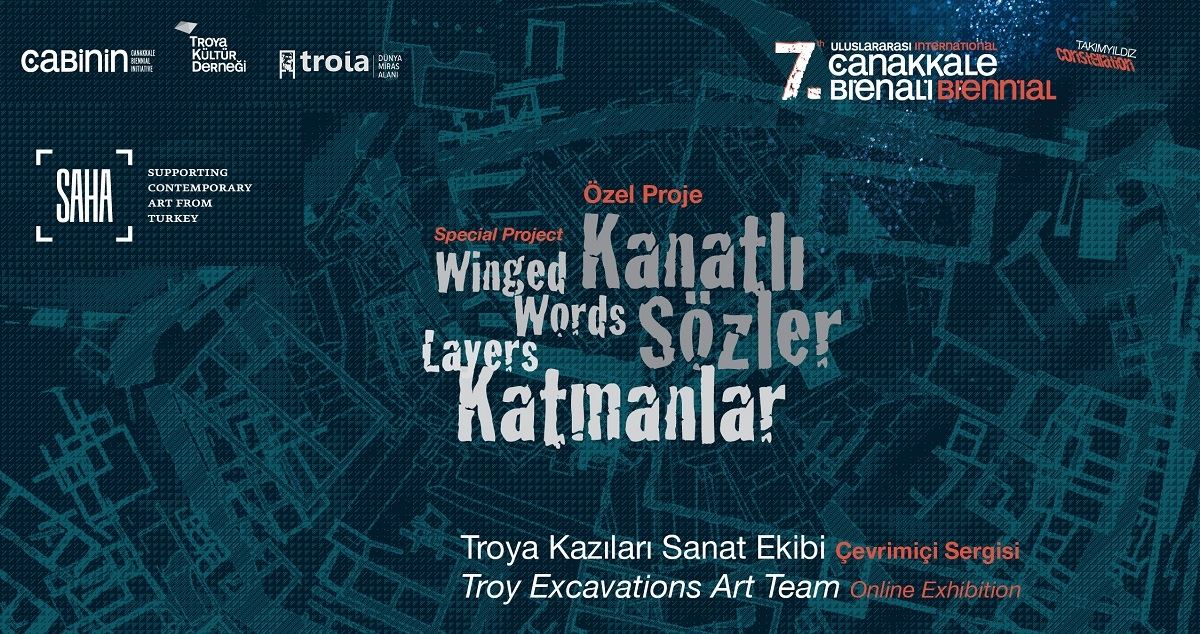Winged Words / Layers, Troy Excavations Art Team, Online Exhibition
7th Çanakkale Biennial, Special Project: Winged Words / Layers
Troy Excavations Art Team, Online Exhibition
25 December 2020 – 25 January 2021
Artists: Burak Topçakıl, Erdal Sezer, Mehmet Erim, Ülkü Sönmez, Yağmur Ebru Metin, Yeliz Saydan
Curators: Deniz Erbaş, Seyhan Boztepe
Consultant: Prof. Dr. Rüstem Aslan
“There is a strong analogy between the archaeologist’s trench as the theatre of endeavour and the choice that the artist has to make: ‘This is what interests me, I am focusing on this’. Then, of course, the artist’s imagination takes off and does many different things.” Colin Renfrew: A Conversation”, Art and Archaeology, Ed. I.A. Russell & A. Cochrane, Springer, 2014, p.11
Colin Renfrew, an archaeologist who focuses on the relationship between contemporary art and archaeology, emphasizes the potential for the relationship and interaction of these two practices, and the analogy between an archaeologist and an artist. According to Renfrew, the archaeologist and the artist's interest in material, object, space, memory or knowledge, united in a common search for the human condition, opens a space where the line between science, craft and art is blurred. It may be that the artist will learn from the obsessive elaboration of the archaeologist when dealing with its subject or material, from his meticulousness to magnifying the smallest details. As the archaeologist looks at a trench, he can feed off the artist's creativity, which includes all kinds of sensory experience, experimentation and intuition into the process.
It is quite possible to look at the similarity between these two practices that focus on today's cultural production from different angles. A visitor in a contemporary art exhibition also has to make sense of, unravel or grasp the material world they face, with an archaeologist-like perspective. Another analogy becomes visible during the exhibition of the archaeological site. The archaeologist, just like the curator, must decide how the archaeological site, which is the scene of his archaeological work, will be staged in what order, what will be shown, what kind of story will be constructed, and how knowledge and experience will be conveyed. After that stage, the ruin is an exhibition in the full sense of the word.
Could Troy be a common ground where the potentials of archaeologists and artists coming together in the light of all these analogies, ideas and expansions will be discussed? Troy, which is the memory space of both the archaeological studies approaching two centuries and the Homeric epics that have nurtured the imagination in different parts of the world throughout the ages, is also a source that feeds the generations of artists living in Çanakkale and working with different mediums. In addition to the ruin, where the remains, stones and debris are intertwined with nature, the finds exhibited in the Troy Museum are visually quite attractive and impressive. The opening of the Troy Museum in 2018, the coexistence of the archaeological site and the museum created a rich cultural space that feeds knowledge, experience and interaction by referring to each other and complements each other. Still, there is a need for relationality that goes beyond the aesthetics of ruin, mythological poetry, the magic of archaeological objects that reflect the aesthetics of centuries ago. Just like an archaeologist, travelling through the depths and layers of the superficial and visual can both contribute to the development of their own practices and stimulate a different thinking and production process about the intersection areas of archaeology and art through Troy in the context of today's art.
Starting with the question of how can a different relationship be possible between both Troy Ruins and archaeology practice and artists, Troy Excavations Art Team is conceived as a platform where artists and curators can enter the research area of archaeologists, experience the works of the archaeological site and the background of the museum so that archaeological and artistic processes can be fed from each other. It became official in 2020 as a backdrop. Artists and archaeologists had the opportunity to think together and discuss each other's practices in the works carried out in accordance with the pandemic conditions. The Winged Words / Layers exhibition brings together the productions that are the results of this six-month-long period.
The 2020 period of the Troy Excavations Art Team, which is a first in its field in Turkey, as well as the Winged Words / Layers exhibition is supported by SAHA Association.
